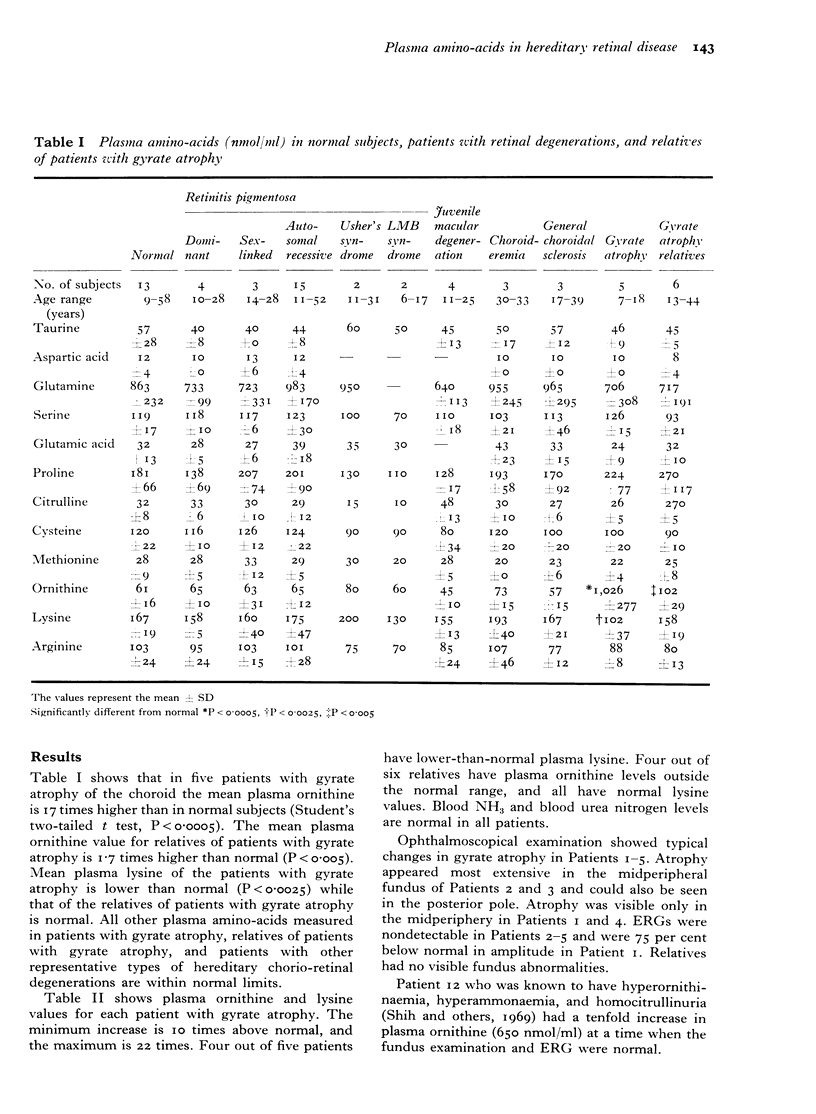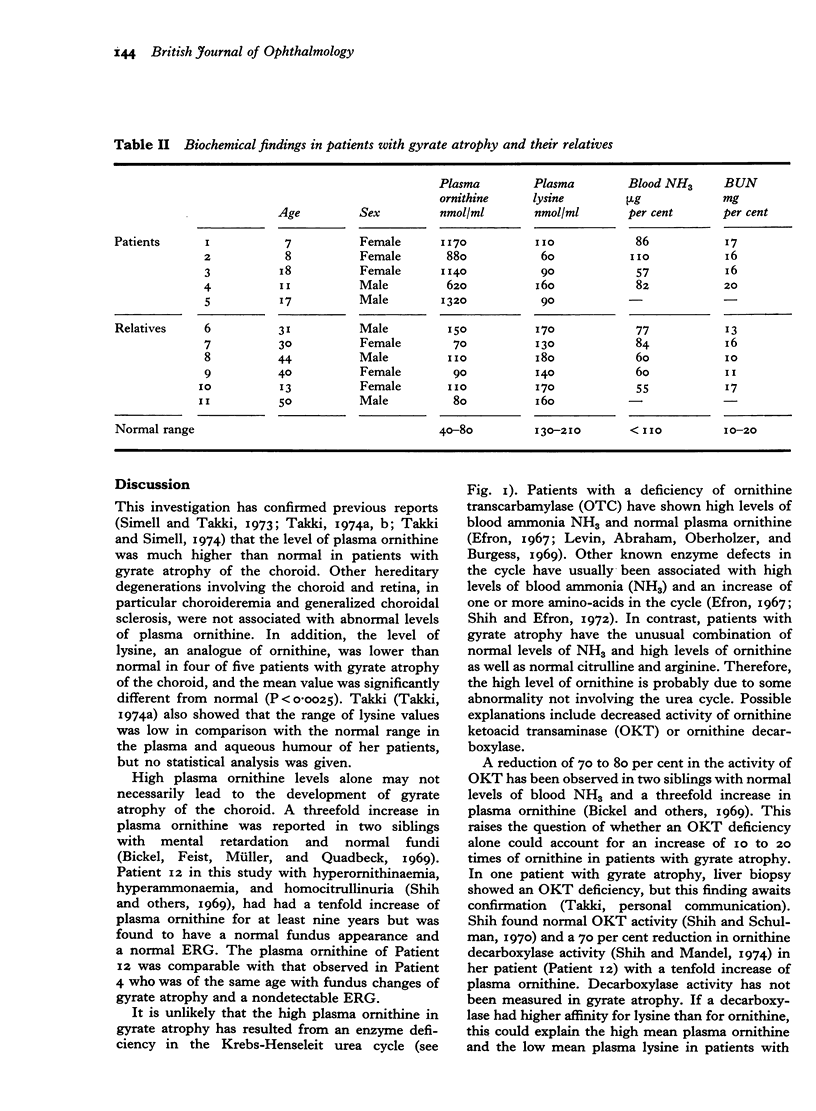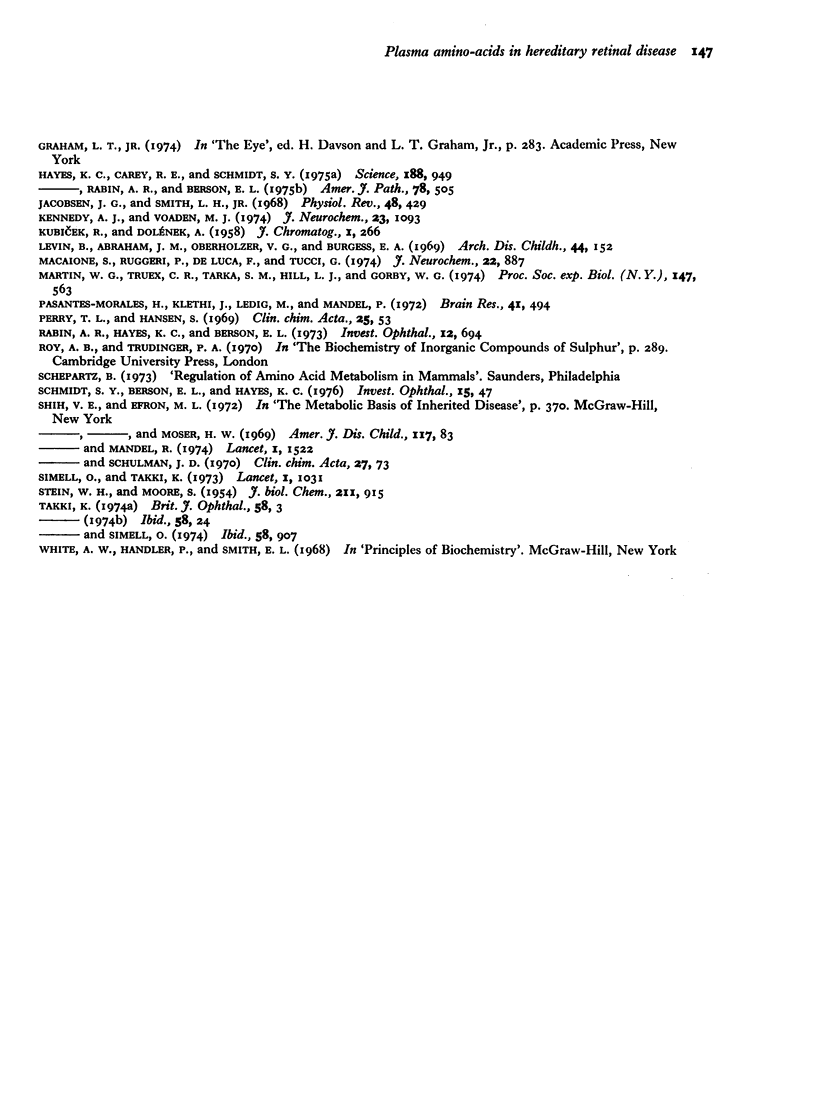Abstract
Plasma free amino-acids were measured in 41 patients with hereditary chorio-retinal degenerations including 26 with retinitis pigmentosa and five with gyrate atrophy of the choroid, six relatives of patients with gyrate atrophy, and 13 normal subjects. Patients with gyrate atrophy had very increased levels of ornithine and slightly decreased mean lysine values. Most relatives had slightly increased ornithine. Taurine, known to be deficient in the plasma of casein-fed cats with photoreceptor degeneration, was normal in all patients. Amino-acid precursors and metabolites of ornithine and taurine were also normal in the plasma. Although the association of high ornithine and gyrate atrophy appears constant, high levels of ornithine alone do not necessarily lead to this degeneration; one patient with known hyperammonaemia, homocitrullinuria and a tenfold increase in plasma ornithine was found to have a normal fundus appearance and normal electroretinogram.
Full text
PDF





Selected References
These references are in PubMed. This may not be the complete list of references from this article.
- Cohen A. I., McDaniel M., Orr H. Absolute levels of some free amino acids in normal and biologically fractionated retinas. Invest Ophthalmol. 1973 Sep;12(9):686–693. [PubMed] [Google Scholar]
- Ehinger B., Lindberg B. Light-evoked release of glycine from the retina. Nature. 1974 Oct 25;251(5477):727–728. doi: 10.1038/251727a0. [DOI] [PubMed] [Google Scholar]
- Hayes K. C., Carey R. E., Schmidt S. Y. Retinal degeneration associated with taurine deficiency in the cat. Science. 1975 May 30;188(4191):949–951. doi: 10.1126/science.1138364. [DOI] [PubMed] [Google Scholar]
- Hayes K. C., Rabin A. R., Berson E. L. An ultrastructural study of nutritionally induced and reversed retinal degeneration in cats. Am J Pathol. 1975 Mar;78(3):505–524. [PMC free article] [PubMed] [Google Scholar]
- Kennedy A. J., Voaden M. J. Free amino acids in the photoreceptor cells of the frog retina. J Neurochem. 1974 Nov;23(5):1093–1095. doi: 10.1111/j.1471-4159.1974.tb10766.x. [DOI] [PubMed] [Google Scholar]
- Macaione S., Ruggeri P., De Luca F., Tucci G. Free amino acids in developing rat retina. J Neurochem. 1974 Jun;22(6):887–891. doi: 10.1111/j.1471-4159.1974.tb04313.x. [DOI] [PubMed] [Google Scholar]
- Pasantes-Morales H., Klethi J., Ledig M., Mandel P. Free amino acids of chicken and rat retina. Brain Res. 1972 Jun 22;41(2):494–497. doi: 10.1016/0006-8993(72)90523-9. [DOI] [PubMed] [Google Scholar]
- Perry T. L., Hansen S. Technical pitfalls leading to errors in the quantitation of plasma amino acids. Clin Chim Acta. 1969 Jul;25(1):53–58. doi: 10.1016/0009-8981(69)90226-5. [DOI] [PubMed] [Google Scholar]
- Rabin A. R., Hayes K. C., Berson E. L. Cone and rod responses in nutritionally induced retinal degeneration in the cat. Invest Ophthalmol. 1973 Sep;12(9):694–704. [PubMed] [Google Scholar]
- STEIN W. H., MOORE S. The free amino acids of human blood plasma. J Biol Chem. 1954 Dec;211(2):915–926. [PubMed] [Google Scholar]
- Schmidt S. Y., Berson E. L., Hayes K. C. Retinal degeneration in cats fed casein. I. Taurine deficiency. Invest Ophthalmol. 1976 Jan;15(1):47–52. [PubMed] [Google Scholar]
- Simell O., Takki K. Raised plasma-ornithine and gyrate atrophy of the choroid and retina. Lancet. 1973 May 12;1(7811):1031–1033. doi: 10.1016/s0140-6736(73)90667-3. [DOI] [PubMed] [Google Scholar]
- Takki K., Simell O. Genetic aspects in gyrate atrophy of the choroid and retina with hyperornithinaemia. Br J Ophthalmol. 1974 Nov;58(11):907–916. doi: 10.1136/bjo.58.11.907. [DOI] [PMC free article] [PubMed] [Google Scholar]


